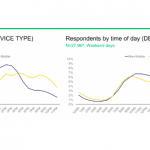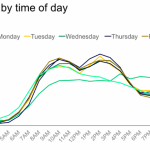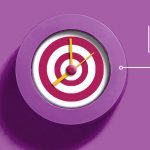So much of the success of your survey depends on getting enough responses—and the right responses. Sending a survey that gets overlooked is like cooking a delicious, elaborate meal that no one is hungry enough to try.
It turns out that getting enough survey responses —like dining—often comes down to catching people at the right time. So what’s the best time to send your survey so that you get the most responses?
We looked at hundreds of thousands of SurveyMonkey surveys to identify the days and times that get tend to get the best response rates and what other factors come into play when you switch up times.
Your survey’s timing could affect where respondents sees your survey
Your intuition probably tells you that when you’re sending an online survey, you want to catch people when they’re focused—which probably isn’t over the weekend.
You’d be right—our data shows that response rates are significantly stronger on the weekdays—but there’s another layer too.
Respondents who fill out surveys during off times (like late afternoons and evenings) are more likely to reply on mobile devices than on their computer. That means that if you catch them during these times, they’re likely to be typing out answers on their phone.

Why does that matter? If you’re asking a lot of open-ended questions that take more work to respond to, your survey might lose respondents on mobile. Alternatively, if you’re concept testing a new digital graphic, you might want people to see it on their phones to see how it comes across on mobile.
When’s the best time of day to send a survey?
You probably won’t be too shocked to learn that very few people are responding to surveys on Tuesdays at 3 a.m.
On Mondays, responses start to pick up around 7 a.m., then continue throughout the morning until reaching a peak at 10 a.m., dropping off during the lunch hours, peaking even higher at 2 p.m., before dropping off again until the next morning.
Data for Tuesdays, Wednesdays, Thursdays, and Fridays all follow the same pattern as Monday. In general, sending your survey earlier in the day seems like the best way to secure responses.
(Hint: if you don’t want to wake up early or lose Monday morning productivity, you can schedule your survey to send automatically at a given date and time.)

There’s one exception to the up-and-down pattern: weekends. Responses on Saturdays rise through the early morning and reach a peak around 10 a.m., just like on weekdays, but then they peter out. Apparently people have better things to do on Saturday afternoons and evenings rather than answer surveys. If you do want to target people on the weekend, earlier mornings are (again) better.
When’s the best time to send post-event surveys?
Survey timing isn’t always a one-size-fits-all formula. One notable exception is surveys sent after events. Another is after a change in relationship (e.g. a customer buying a new product, changing their subscription, etc.)
If you’re following up after a group event (conference, webinar, concert, etc.), there’s no reason to wait for the following Monday. Instead, our resident event-planning expert (and survey power user) Berenice Lai recommends shipping your survey within a day or two after the event.
“You’re going to want to catch them while it’s fresh in their minds. People go to a lot of events, and they’re going to forget the little details that they liked or disliked if you wait too long. If you wait long enough, they might even confuse your event with others they’d been to. Ask when it’s fresh and they’re still excited to get the best insights.”
If you’re short on time, you can create your survey in advance and schedule it to send the day after the event.
For transactional surveys (after purchase, etc.), you can set up an automatic triggers with our Zapier integration—just make sure to consider what type of timing makes the most sense for that point in the customer’s journey. For example, if the customer just bought a product, give them a few months to get to know it before you ask what they think.
We want to help you get as many respondents as possible, so that all your hard work pays off. Timing it right might help.



